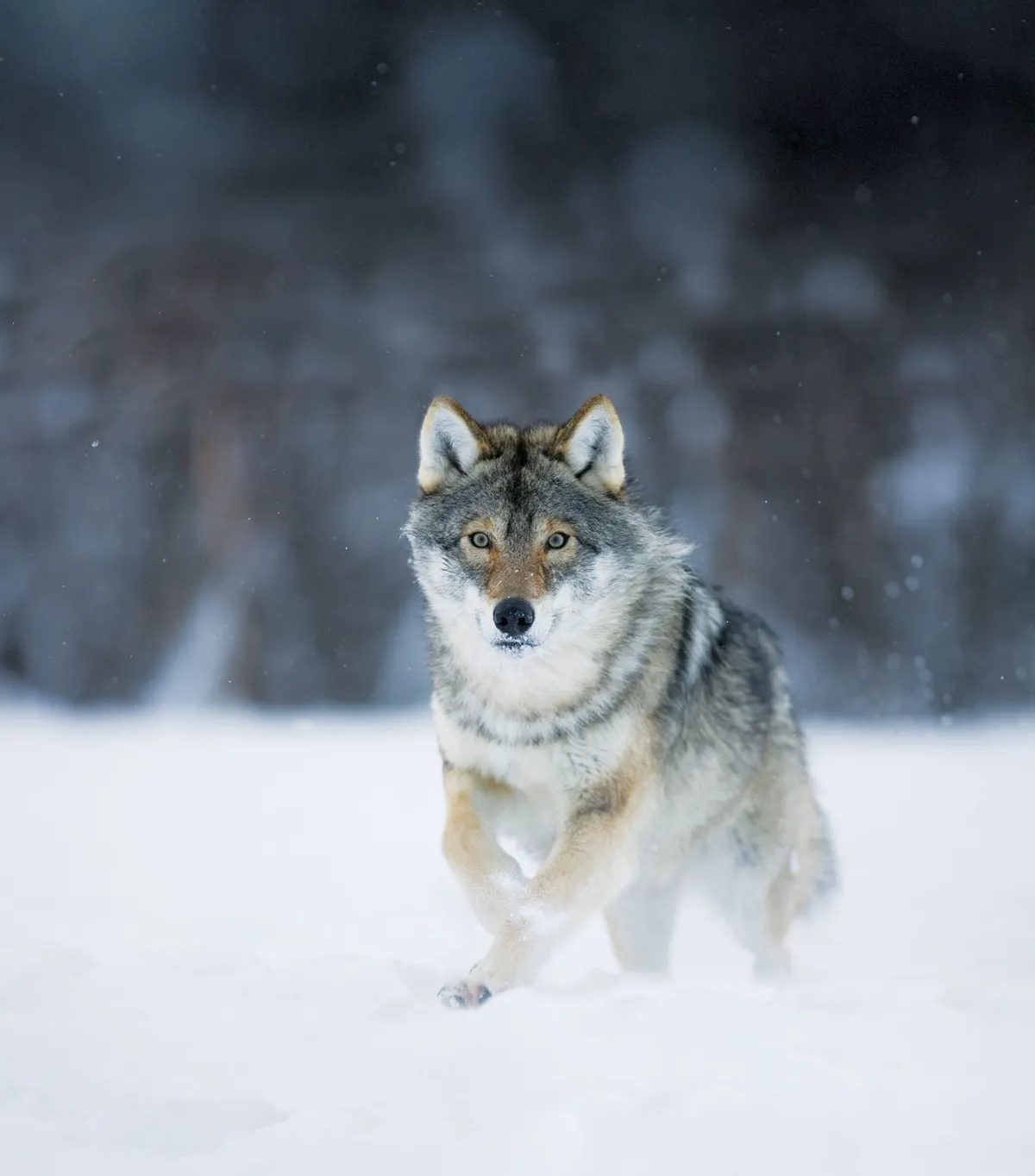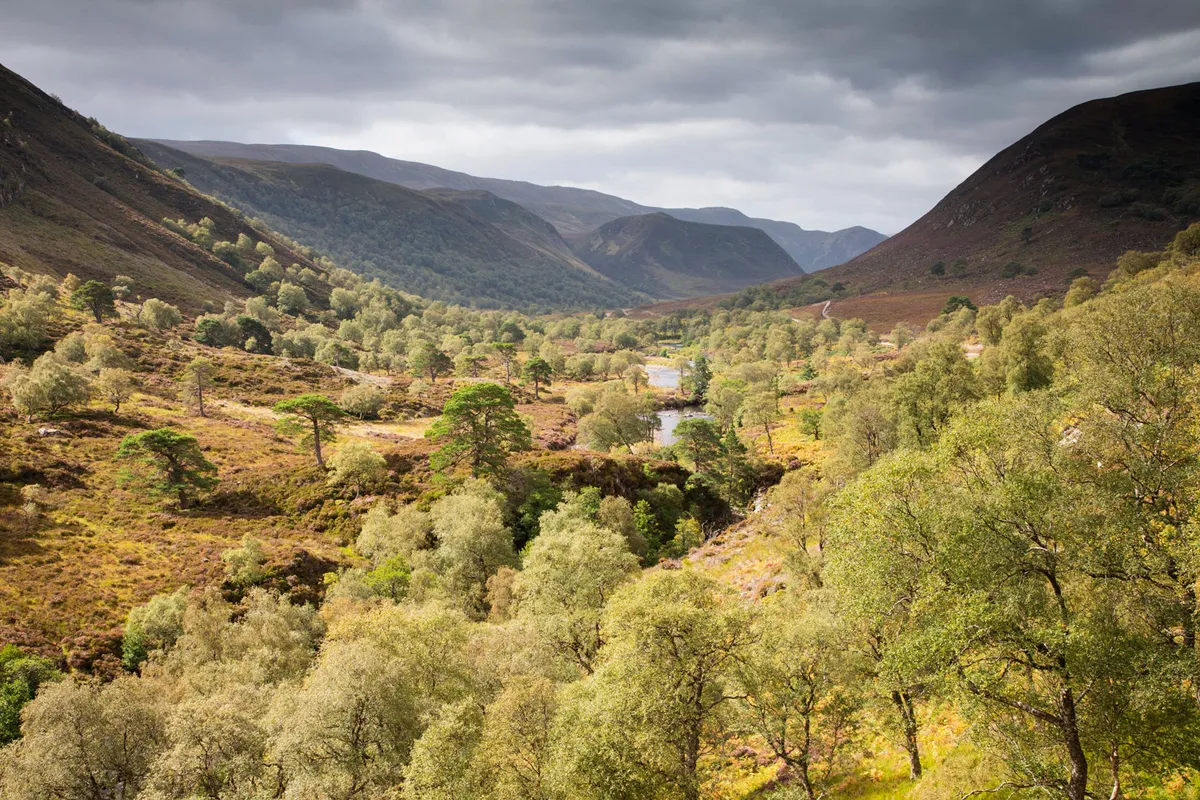On the day I arrive in the Västmanland province in Sweden, a wolf walks across a packed school playground in the remote hamlet of Kolsva. The wildlife officers in the provincial capital of Västerås are perplexed. They have been tracking this rogue animal since it started snatching domestic animals from local back gardens at the beginning of the summer. The number of on-duty teachers the next day at playtime is increased, and marksman are deployed in the woods.
Wolves are currently in renaissance across Europe. With the help of EU protection as well as national level initiatives, these keystone predators can now be found once again in almost every European country besides the UK. Their presence has been credited with everything from reawakening our inner wild man, to reducing overgrazing, encouraging biodiversity and even helping divert flood-prone rivers. In March 2017, six Swedish wolf cubs were brought to live at the Wildwood Escot enclosure in Devon, with the mooted goal of their potential reintroduction to Scotland. I am now on the ground in Swedish wolf territory, to investigate how practical that proposition really is.
King of the canines
“Swedes want to see wildlife,” begins wildlife officer and game warden Tobias Hjortstråle. A persistent autumn rain is falling outside the warm offices of the County Administrative Board in Västerås. Beyond the sodden streets stand dense pine woodland. Forests occupy 70% of the country’s landmass and it’s somewhere among those great expanses where ‘Scandinavia’s Big 5’ – golden eagle, brown bear, wolverine, lynx and grey wolf – can still be found. Tobias looks out towards these wilds as he speaks. “80-90% of us,” he continues “are in favour of wolves.”

Wolves were never completely missing from the Swedish landscape. When their numbers bottomed out at around 10 animals in the 1960s, the Swedish Government stopped rewarding hunters for culling, and instead made the king of the canines a protected species. “99.99 of the time a wolf will never attack a human,” explains the warden. But a freak killing spree in the 1820s by the unnaturally domesticated and recently dramatised ‘wolf of Gysinge’ has lived long in Swedish memory.
A driver should be wary of jaywalking moose that stride out unannounced. “If wolf didn’t kill moose,” lead researcher Jens Frank tells me upon my arrival, “we [human beings] would.” Those same spruce and pine trees I’ve been driving through are an important cash crop in the north of the province. The wolves play a role in preventing saplings being grazed to the ground.
Wolf Spectre
“Wolf urine, pass it on,” whispers Wild Sweden wolf guide Marcus Eldh. We are now far from the road, in the remote forest territory of the Aspa wolf pack. Currently I’m crouched on all fours among coral reefs of reindeer lichen, and I’m sniffing enthusiastically for scent markings. Marcus points to a runnel of bent wet grass. “Their bodies were close to the ground here – they must have been cubs,” he says.
We spend the evening living on our senses. The possibility of a sighting seems to lurk behind every boulder and tree trunk. As night falls, we make a fire to push out the darkness, and sit around listening for the call of the wild.
Of course, with each wolf pack comprising an average of just 10 members over a territory stretching 230-300 square miles, our chances are slim. There are still only 400 wolves in the whole of Sweden. A third of them die every year due to scabies, drowning in ice, as well as road and rail accidents. Only 10% make it to adulthood.
Additionally, in 2015, a select Västmanland committee – composed almost entirely of moose and deer hunters – voted for a wolf cull in the province aimed at “reducing socio-economic consequences and improving possibilities for domestic animal husbandry”. The decision was overturned by Swedish courts. But the greatest threat to wolves is still illegal hunting.
Over the next two days I shoulder my tent, sleeping bag and camping stove and hike east with my companion into the territory of the Färna wolf pack. The Bruksleden trail leads us on a rugged ducking, side-stepping, bog-wading odyssey through the backcountry. While the path is never straightforward, the vast green forest is a constant. Scotland by comparison is a barren and, to quote environmental journalist George Monbiot, “sheepwrecked” environment.
“Wolves,” Tobias Hjortstråle had assured me, “are the most adaptive animal on the planet,” found living in deserts, the Arctic and even city garbage tips in India. Yet wherever they threaten farmers’ livestock, their days, I’m about to learn, are numbered.
Rewilding reality check
Hellen Wistrand greets me on the edge of her Wildlife Safari and Lodging property, in the isolated outpost of Ulvsbomuren. Living alone here and managing her modest eight-hectare sheep farm, she sits on the select committee that voted in favour of the wolf cull. “When I came here 13 years ago, there were no wolves,” she explains.

While Hellen doesn’t own a gun, she sets out to monitor her sheep fence in rain or darkness if the power metre flashes red, saying “I worry about them every day”. If a wolf did get through her electric fence, it would be likely to kill a dozen animals.
As dusk, we walk out into the pasture in order to inspect the electric fence. Here on this remote island in the Swedish forest, the Färna wolf pack seems to have enough prey for now, and has never breached Hellen’s defences. The wolf, she tells me, “is a polarised issue between countryside and city life”.
Elsewhere, I have been told in confidence that wolves approaching other farms are sometimes shot to avoid paperwork and potential criminal proceedings, and are hurriedly buried.
The UK’s wilds have not seen wolves for the past 300 years. Here, where road and rail infrastructure is denser and where open hill farming replaces electric fences, the scale of conflict and challenge that reintroducing wolves would create seems insurmountable – for now. Every Swedish wolf expert has told me so. And yet, as the sky flushes red over the endless forest, I feel that earthy pulse, that forgotten wild feeling that still broils up in untamed places. Perhaps before reintroducing the wolf to the UK, we first need to consider rewilding our landscapes – and perhaps a little of ourselves, too.
Wolf Facts
• Wolves can sense up to 1.5 seconds of difference in the oxidisation of a scent, allowing them to precisely date and orientate their prey’s direction of travel
• In Sweden, where fenced sheep farming is practiced, the 400 wolves kill 500 sheep every year
• In Norway, where open hill farming is practiced, (similar to the UK), the 68 wolves kill 1,600 sheep every year
Alladale: The British rewilding project

For the past 10 years, Paul Lister has been one of the leading voices on British rewilding. In his 36 square mile Alladale Wilderness Reserve in northern Scotland, he has planted 850,000 trees. He is now hoping to double the reserve’s size; enclose it in the style of South African wildlife parks and have a controlled release of wolves and brown bears.
“Due to the problems currently being experienced in Germany, France and Sweden with wolves, we won’t get permission to have wolves roaming free in the UK any time soon,” he says. “For the past 500 years in Great Britain, our landscape has been sanitised. In our now densely populated landscape that is full with sheep, reintroducing wolves would not be the next best step – however, lynx would stand a good chance. Currently there are tentative plans for their release in the 250 square mile Kielder Forest in Northumberland.
“The tree planting at Alladale is a long-term project. Lynx and other species rely on forests for hunting as well as cover, and so our woodland won’t really be appropriate for them for another 20 years. It’s a valid argument that reintroducing species in the enclosed reserve at Alladale, as well as properly rewilding further afield, will increase jobs in economically suppressed areas of the UK.
“An even more powerful argument, I believe, is that we got rid of the species and therefore we should bring them back. Life is empty without them.”
Matt Maynard writes and photographs environmental and adventure stories
Main image: Alamy
